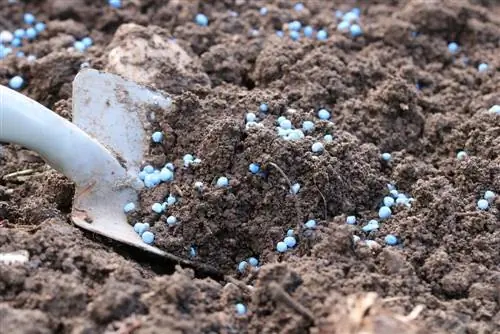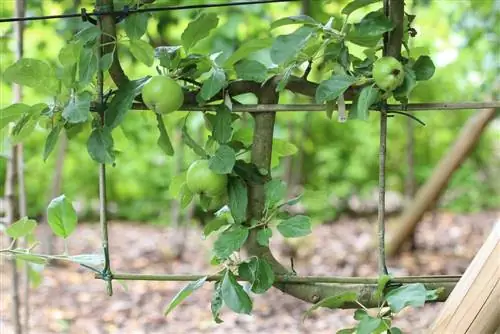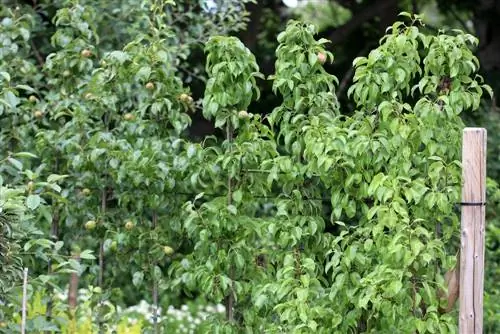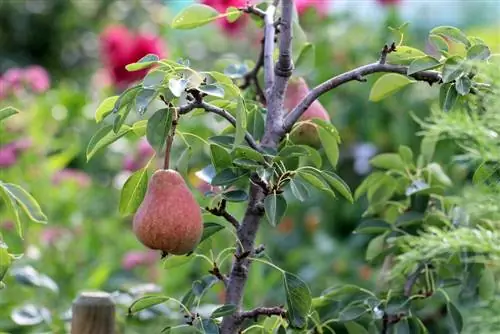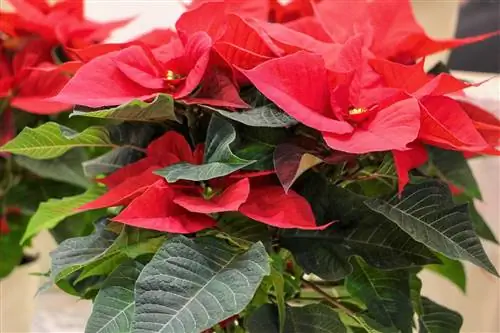- Author admin [email protected].
- Public 2023-12-17 03:39.
- Last modified 2025-01-24 12:45.
Feathery leaves and pink flowers - the star fruit is an unusual and still rare houseplant. If it is cultivated outside in summer or if it is self-pollinated, it can even enrich the menu with its he althy fruits. And the demands of the exotic are so manageable that even beginners quickly see success. Despite its beauty and easy care, there are a few points to consider when it comes to carambola. Especially if you want it to bring joy for a long time.
Location
The star fruit comes from Southeast Asia and therefore requires a warm and sunny location that is protected from the wind. In the summer it can be left outdoors, but due to its high moisture requirements it is better kept in the winter garden or in the apartment. A humidity of 70 percent is optimal here, which means that in addition to the greenhouse, the kitchen and bathroom are also suitable. The carambola is rather unsuitable for the indoor greenhouse as it can reach a height of up to three meters.
Substrate
The exotic star fruit is uncomplicated when it comes to choosing the substrate. Commercially available, high-quality potting soil is sufficient. However, adding a little compost and loamy soil or - if this is not available - clay powder is also very helpful. Overall, mixing in the clay makes sense when cultivating carambola, as it can better store the moisture in the soil. However, the substrate should not tend to compact as a result. If you want to be on the safe side, add some expanded clay to the soil.
Pouring
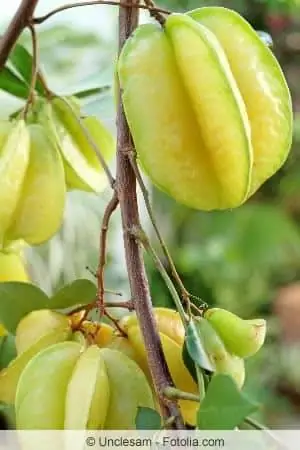
Due to its warm and sunny location, the star fruit requires plenty of water and must therefore always be kept moist. However, it is moist, not wet, because the carambola has a hard time with waterlogging. Regular watering is necessary, especially in summer, and it is best to keep the substrate completely moist. This can be easily achieved by dipping the pot. The pot is completely submerged in a bucket of water until the soil is saturated. This condition can be recognized by the fact that bubbles no longer rise from the substrate. Excess water must then drain and drip off.
Tip:
The star fruit tolerates lime poorly and should therefore not be watered with hard tap water. Rainwater, filtered or stale tap water is better.
Fertilize
When fertilizing, the star fruit is again completely unproblematic. All you need is a commercially available complete fertilizer in liquid form, which is added to the irrigation water from spring to summer. Fertilization is carried out approximately every two weeks, from April to September. When choosing products, it is important to ensure that they do not have any negative effects on the fruits themselves - so they are suitable for plants that are intended for consumption. More cost-effective and natural alternatives to commercial fertilizers are coffee grounds, compost and nettle manure.
Blend
Blending the star fruit is not necessary at all. However, damaged or unwanted shoots can be removed. Dead parts are cut off promptly, overgrown shoots are cut off in March.
Repotting
Changing the pot regularly is not necessarily necessary for the carambola. Repotting is only necessary when the plant has become too large for the container, is no longer secure in it or roots become visible in the bottom of the pot. As with many plants, it is advisable to choose a pot that is only slightly larger for starfruit. In this way, root growth is limited and the plant sprouts more strongly.
Fertilization and harvest
The star fruit does not produce flowers until the third year at the earliest. If these are pollinated by insects or a brush, fruits can develop from them. Depending on the location, sun and temperature, ripening can occur in early or late autumn. To do this, first just cut off one fruit and open it. If the flesh is yellow-orange, the star fruits are ripe.
Tip:
If you choose a self-fertile carambola, you will not need any additional specimens for fertilization.
Propagation
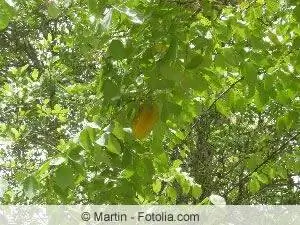
The star fruit is propagated via seeds, which should be sprouted as quickly as possible after collection. Commercial fruits often only contain very small seeds that are not suitable for germination. It therefore makes sense to first purchase a plant that has already been grown and propagate it. The largest seeds should be obtained from the fruits, which should then be germinated in the following steps.
- Clean the seeds thoroughly and remove all pulp.
- Place the seeds on growing soil and only cover them lightly with the substrate.
- Moisten the soil but do not soak it, cover the container with glass or transparent film.
- Place the planter in a bright location that is illuminated with a plant lamp over the winter.
- It should be at least 25 °C.
Some seeds can germinate in the first two weeks, but success is not guaranteed. Repotting into nutrient-rich substrate can be done when the young carambola is around 15 cm high.
Wintering
The star fruit can only withstand temperatures of up to 3 °C for a short time and must therefore be kept indoors over the winter. It is ideal if it is allowed to stand here at more than 12 °C, otherwise it will lose its leaves. Room temperatures are also suitable. In addition, the carambola must be kept bright and continue to be watered. Only fertilizing needs to be stopped.
Typical diseases, pests and care errors
Diseases and pests only occur very rarely on the star fruit. She suffers much more often from care errors. Typical here are:
- a location that is too dark or too cool
- Deficiency symptoms, such as discolored leaves
- insufficient water supply and humidity
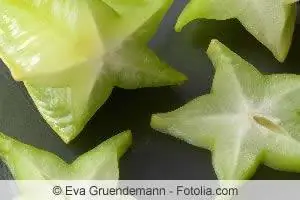
If the leaves turn brownish, they are also folded during the day, if there are no flowers or fruits, the cultivation conditions must be checked carefully and adjusted accordingly.
Frequently asked questions
Is star fruit really he althy?
For he althy people, star fruit is a great addition to the menu. Things are different for people who suffer from kidney disease. The fruits contain a substance that can cause severe symptoms of poisoning in kidney disease. Severe insufficiencies or large amounts of carambola can even lead to coma or death.
Why do carambola leaves close?
If the star fruit literally folds its leaves, this is not always a cause for concern. Instead, overnight this is a completely normal process. Different during the day. Here the phenomenon can indicate a lack of water or a location that is too bright - the culture conditions must therefore be checked.
Why isn't my star fruit bearing fruit?
It usually takes at least three years for the star fruit to even bloom. Even then, it is not yet certain that the flowers will produce fruit. Fertilization is usually carried out by insects; if they do not reach the carambola, no fruits are produced. The plant should therefore be placed outside in summer or pollinated by hand with a brush. If the harvest is still low, the wrong location, too few nutrients and a lack of water can be responsible.
What you should know about carambola in brief
Location
- In summer you can put the planter outside.
- The plant likes a bright, sunny and absolutely protected location.
- It is important that it is protected from overheating. So blazing midday sun is not so suitable.
- If you want to harvest fruit, it is best to place the carambola in the winter garden or in a warm house.
Planting substrate
- High-quality potting soil is ideal.
- It should contain coarse grains such as lava grit or expanded clay, as it will then be loose enough.
- The humus content must also be balanced.
- The plant substrate should be able to store water and nutrients.
- It is important that the planter is not too big.
- Repot about every 3 years, but choose the container just a little larger.
Watering and fertilizing
- Consistent soil moisture throughout the summer is crucial.
- Humidity around 70% is ideal. The best way to reach this is in the glass house.
- In summer you usually need to water abundantly.
- Standing moisture should be avoided.
- On the other hand, you don't need to fertilize much. It is enough to provide nutrients with complete fertilizer every 10 days.
- Too much fertilizer harms the plant. It often leads to soil salinization and root damage.
Cutting
- The star fruit does not need to be cut, but you can do so at your own discretion.
- If necessary, shorten fresh shoots that have become too long in March/April.
Wintering
- The star fruit needs a bright location and temperatures around 18 ˚C.
- In the short term, the plant can also cope with temperatures of up to 3 ˚C.
- Maintain even soil moisture! Nevertheless, water significantly less.
- When leaves fall off, the need for water decreases because not as much evaporation occurs.
- The cooler the plant is, the more leaves it sheds. At around 12 ˚C it loses almost all of its leaves.
Propagate carambola
- Propagation occurs by seeds. These are obtained from completely ripe fruits.
- Often you won't find any in the fruits, they are specifically bred that way.
- Remove the pulp completely from the seeds; it is best to wash them under water. Dry carefully.
- Culking soil is suitable as a planting substrate. Cover the seeds lightly with soil.
- Keep it warm and bright, but not in the sun. 25 to 28 ˚C and artificial light (plant lamp) are ideal.
- The seeds germinate differently, some after just 14 days, others only after weeks.
- There are self-fertile varieties and those that require a pair of plants.
Diseases and pests
- Sometimes scale insects appear in winter.
- When overwintering is too cold, root damage is quite common.
- Dry air damages the plant, as does greatly fluctuating water supply.
- The fungus gnat likes the evenly moist plant substrate, but is quite easy to control.


